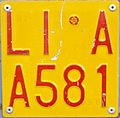Italian car number plates facts for kids
Italian car number plates are special signs on cars that help identify them. They are like a car's ID card! In Italy, these plates used to show where a car was registered. But now, the system is different. Modern Italian car plates have black letters and numbers on a white background. They also have small blue sections on the sides. The numbers on these new plates are given out in order, so they don't tell you where the car owner lives anymore.
Contents
Italian Car Plates: Past and Present
Car number plates in Italy have changed a lot over time. For many years, the plates would tell you the exact city or province where a car was registered. This made it easy to know where a car came from just by looking at its plate.
How Plates Used to Work
Before 1994, Italian car plates often had a code for the province. For example, a plate might have "LI" for Livorno or "PG" for Perugia. Sometimes, the provincial code was at the beginning, and sometimes it was at the end. This system helped people know the car's origin. It was a common way to identify vehicles across Italy.
The Current Italian Plate System
Since 1994, Italy uses a new system for car number plates. This system is used all over the country. It gives out numbers and letters in a sequence. This means the plate number does not show where the car was registered or where the owner lives. This makes the system more fair for everyone.
Design of Modern Plates
Current Italian car plates have a very clear design. They feature black characters on a white background. This makes them easy to read. On both the left and right sides, there are small blue sections. These blue sections add extra information and follow a common European design.
What the Blue Parts Mean
The blue section on the left side of the plate is standard across many European countries. It shows a circle of 12 yellow stars, which is the symbol of the European Union. Below the stars, you will see the letter "I". This "I" stands for Italia, which is Italy's name in Italian.
The blue section on the right side of the plate is optional. It can show two numbers that tell you the year the car was registered. For example, "12" would mean 2012. Below the year, there can be a two-letter code for the province. For example, "FI" stands for Florence. This part helps people who want to know the car's original province.
Special Vehicle Plates
Not all vehicles in Italy use the standard white plates. Some special vehicles have different types of plates. For example, military vehicles, police cars, and fire trucks have their own unique plate designs. These special plates help identify them quickly. They often have different colors or specific letter codes.
Examples of Special Plates
- Military Vehicles: Plates for the Italian Army (Esercito Italiano) or Navy (Marina Militare) have unique codes.
- Emergency Services: Firefighters (Vigili del Fuoco) and the Italian Red Cross (Croce Rossa Italiana) also have their own distinct plates.
- Trailers: Trailers used to have different plates, but their system has also changed over time.
These different plates help keep track of all the vehicles on Italian roads.
Images for kids
-
Italian vehicle rear number plate used from 1951 to 1976, LI is the provincial code of Livorno.
-
1976-1985 front and rear Italian car number plates. ROMA is the provincial code of Rome.
-
1985-1994 Italian rear car number plate. VR is the provincial code of Verona.
See also
 In Spanish: Matrículas automovilísticas de Italia para niños
In Spanish: Matrículas automovilísticas de Italia para niños






